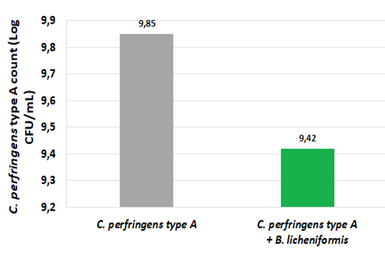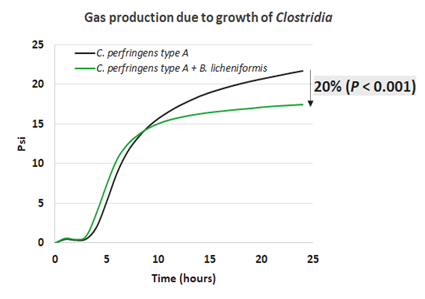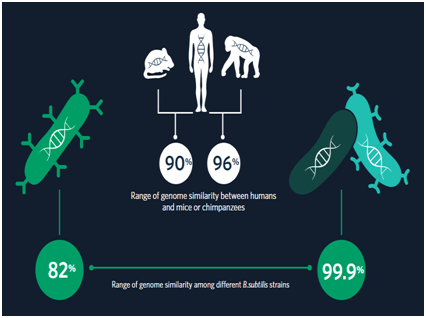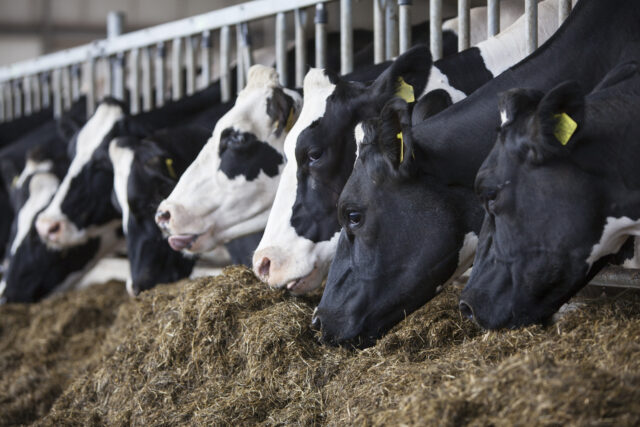Beneficial bacteria are an integral part of the gastrointestinal tract (GIT) of all species, including humans and ruminants, being known as ‘gut microbiome’. This complex group of microorganisms presents key roles to the maintenance of the GIT, such as immunity, and consequently, impacting directly the health of this organ and the welfare of the herd. Nonetheless, some periods or specific situations within the productive stage of a ruminant animal might lead to a disturbance in the balance of this group of bacteria and in the GIT, such as environmental contamination and ingestion of pathogenic microorganisms, abrupt dietary changes with no adaptation or an adequate preparation of the rumen environment, restriction of water and food for a period of time, uncontrolled use of antibiotics, which in turn, might lead to the occurrence of diseases, such as diarrhea and leaky gut. This scenario becomes even more important when we think about the newborn dairy calf, which is facing a completely new environment and still is in the process of ‘creating’ itsimmunity against the pathogens that might face later in life. Part of this immunity problem can be counteracted by the provision of an adequate amount and quality of colostrum, as colostral immunity is an essential part of enteric disease management, and all calves should receive high-quality colostrum (greater than 50 milligrams IgG per milliliter) within the first few hours of birth (4 – 12 hours). While colostrum is one of the most critical management practices, we need to look at other management practices that help keep calves healthy throughout the pre-weaning and weaning period.
One of these management practices includes the daily use of research-proven probiotics, which has increased in popularity among dairy producers to improve digestive function and health, as well as an alternative therapy that helps to reduce the use of antibiotics through prevention of illness and, thus, reducing the emergence and spread of antibiotic-resistant bacteria and residual antibiotics in milk that the human population will consume. But, before we start, it is important to define the term probiotics and how they can benefit the host.
Definition and attributes of probiotics
Generally speaking, probiotics are defined as ‘live microorganisms that, when consumed in adequate amounts, confer a health benefit to the host’.Besides this definition, a practical one would be that ‘probiotics are a tool to improve health and performance of the livestock through the inhibition of pathogens and improvement of feed digestion’. The World Health Organization and Food Agricultural Organization also identified a set of features that a strain must contain to be considered a probiotic:
- To reach its proposed site of action, surviving the physiological challenges and conditions often faced in the GIT, including pH ranges, presence of bile salts, and digestive enzymes,
- To prove its benefits with an absence of risk for the host, and
- To maintain its physiological properties and remain stable during the feed/supplement manufacturing process, being paramount and dictating the strain type to be used and included in the dairy calves´ supplements.
Probiotics: Mode of Action
Several modes of action have been proposed to probiotics, stabilizing and promoting an adequate function of the GIT, thereby improving nutrient absorption, performance, and overall health and welfare of the ruminant animals. Modes of action include:
- Some strains can block the entry of pathogens into the epithelial cells by providing a physical barrier against these pathogenic microorganisms, in which is referred as colonization resistance.
- Probiotics can stimulate the release of mucus from goblet cells in the GIT and, consequently, the mucus barrier that prevents the interaction of the pathogen and the intestinal epithelial lining.
- Production of antimicrobial compounds (i.e., enterocin and lichenysin) that can kill pathogenic organisms in a direct manner.
- Competition for substrates that could (potentially) be used by pathogenic bacteriaor protozoa for growth and replication.
- Support of the tight junctions in the intestinal cells, preventing the occurrence of leaky gut caused by toxins, pathogenic bacteria/protozoa, or undigested food.
- Signaling to dendritic cells that will support local (gut) innate immunity.
- Prevention or triggering of an innate immune response by interacting with specialized cells that are associated with the digestive tract.
- Some probiotic strains are able to produce enzymes that increase nutrient degradation in the GIT, which in turn will benefit the host and also the bacteria that can use such nutrients for growth and replication.
Altogether, these modes of action help reduce the presence and potential damage that pathogenic microorganisms can cause in the host, strengthening and hastening the immune system response when such challenges are faced, and ultimately, improving the health and performance of the herd.



Figure 1. Inhibitory effects of B. subtilis (1-A) and B. licheniformis (1-B) on C. perfringes type A counts and gas production. A reduction of up to 69 and 20% were observed on counts (colony forming units per mL) and gas production (psi), respectively. Trial conducted internally by Chr. Hansen (Horshoelm, Denmark).
Bacillus spp.: A novel combination of strains to promote the health of the dairy cattle herd
Among the most well-known and research-proven bacterial probiotic strains, Lactobacillus spp., Enterococcus faecium, and Propionibacterium spp. deserve to be highlighted. However, other strains have been evaluated and proven to be effective as probiotics, supporting even additional modes of action that will benefit the host. Among these newly-researched strains are the Bacillus spp. and, more specifically, Bacillus licheniformis and Bacillus subtilis.Bacilli are ubiquitous soil bacteria that perform a variety of functions in the natural world, being included into the monogastric segment for over 25 years with tremendous benefits to the health and productivity of swine and poultry. The main reasons Bacillus-based probiotics have been extensively used for monogastric is due to their spore-forming characteristic and thermo-resistance ability, making it a feasible strain to be included into pelleted feeds, milk replacers, mineral-vitamin mix, and any other liquid or solid supplement type.

Additionally, several experiments in ruminants also support the utilization of Bacillus spp. as probiotic sources for these animals. European researchers demonstrated that B. subtilis and B. licheniformis supplementation during the pre-weaning period yielded a greater average daily gain (+ 50 g) and daily starter intake (+ 130 g) during this period, as well as heavier calves at weaning (+ 2.9 kg). These benefits of Bacillus supplementation could be a combination of (i) a greater health in the GIT during the early trial period, where milk is the main calf feed and the gut is the site where all the nutrients and pathogens are detected and (ii) a greater rumen development, leading to a more efficient nutrient absorption and health.
Research trials conducted by Chr. Hansen evaluated the effects of B. subtilis and B. licheniformis on in vitrogrowth and gas production of Clostridium perfringes type A, a well-known pathogen causing important health and performance losses to the dairy calves. Counts (colony forming units per mL) and gas production (psi) of C. perfringes type A were reduced by up to 69 and 20% when Bacillus strains were incubated with the pathogen (Figures 1-A and 1-B). Moreover, the encounter of a specific pathogen might only be the entry door of other pathogens to start damaging the intestinal and overall health of the dairy calf. In this sense, possible inhibitory effects of B. subtilis and B. licheniformis were also evaluated in an in vitro trial against pathogenic Escherichia coli O157. Bacillus subtilis reduced the binding of E. coli in the intestinal cell by 49%, whereas the reduction was in the order of 76% when B. licheniformis was evaluated, corroborating to the modes of action of probiotics against varied pathogens.
It is extremely important to reduce the prevalence of GIT infections in young calves because when animals are sick at this stage, their subsequent growth is impaired, thus affecting their future productivity. Research from Cornell University estimates that pre-weaned calves treated with antibiotics produce around500 kg less milk in their first lactation as compared to healthy calves. A separate study from CornellUniversity reported that the average treatment cost (medicine only) for diarrhea per calf was $1.12(approximately 85 Indian Rupiah) and a trial from Brazil reported a cost of $1.51 (approximately 115 Indian Rupiah). This information confirms that calfhood illness during the pre-weaning period is expensive and has a long-lasting impact on the profitability of the dairy operation.
Lastly, the Bacillus spp. are able to synthesize and release a wide array of enzymes that will improve fiber and starch digestibility, for example. An in vitro trial conducted at the University of São Paulo (Brazil) demonstrated that 48-h neutral detergent fiber digestibility increased by 22%, whereas 12-h starch digestibility of corn and sorghum increased by 11% when B. subtilis and B. licheniformis were inoculated into the substrate, demonstrating the ability of these strains to produce enzymes that favor nutrient digestibility and performance of the dairy cattle herd.
Following all these results and the benefits of Bacillus spp. in promoting the health and performance of dairy calves, Chr. Hansen launched BovacillusTM, a unique Bacillus-based probiotic containing a mixture of B. subtilis and B. licheniformis, that can be fed to calves and cows in all types of supplements, ranging from a total mixed ration and up to a milk replacer and pelleted supplement.
Strains Matter and the value of research
Commercial products are not the same across all brands and companies select their own strains of bacteria for specific purposes and targets. In this sense, two companies might use bacteria that fall into the same classification and have the same scientific name, and yet, each strain will have its traits and uniqueness related to the selection criteria made by the company.
Ultimately, the value of any probiotic is the research demonstrating its efficacy across various scenarios and challenges. When deciding on adopting a probiotic technology, it is essential to do it based on the available research for the specific product.

Bruno Ieda Cappellozza, Ph. D.1
Oscar Queiroz, Ph. D.2
1Bruno Cappellozza, Ph. D., is the Global Technical Product Manager for Probiotics in Beef & Dairy Cattle for Chr. Hansen.
2Oscar Queiroz, Ph. D., is the Global Product Manager for Probiotics in Beef & Dairy Cattle at Chr. Hansen.















